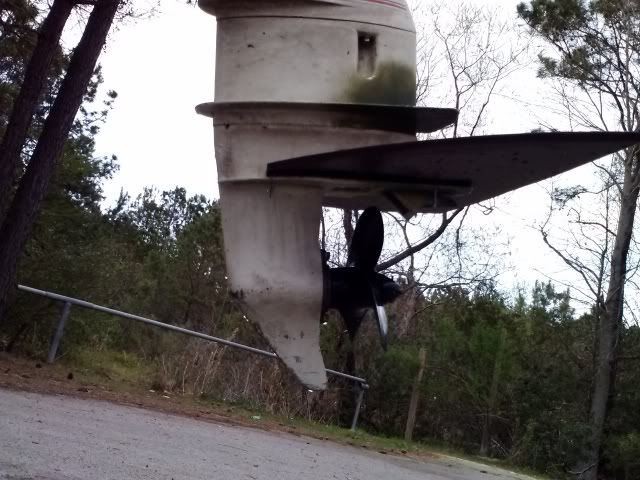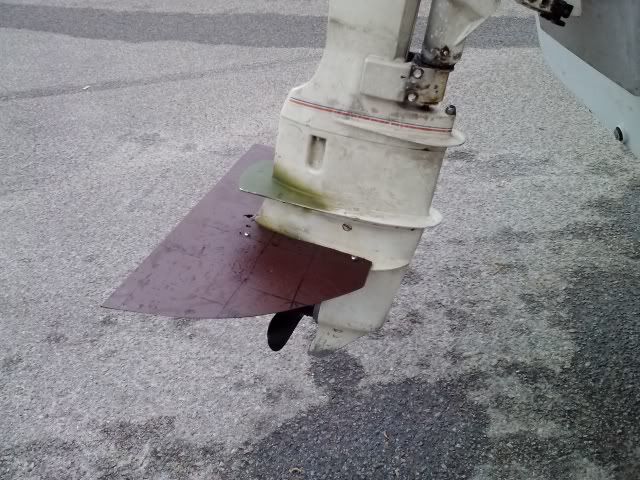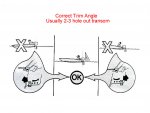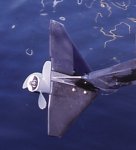Motor-- 1986 Johnson 6hp, clean carb, now running quite well aside from an exhaust leak.
Boat- 14' Starcraft SS (1974) loaded with me (240lb) at the transom, son (50lbs) up front, and maybe 120 pounds in gear/cooler.
Problem-- Boat won't plane out at WOT, but this is to be expected on such a small motor with such a huge rear end sitting in the back.
Solution-- Really just for fun, fabricated a DIY hydrofoil/stabilizer (whale tail).
Material-- offcut of 1/4" Starboard HDPE plastic.
Cost-- $1 for the screws. Starboard stuff was free.
Time-- 1 hour.
Tools--- bandsaw (or jigsaw would work), power sander, drill and associated bits.
I'm posting this at a bit of a risk, because this is a fairly hasty and half-cocked idea that I just threw together yesterday morning before an afternoon fishing trip. I took a scrap of HDPE 1/4" thick, bandsawed out a random whale-tail pattern of a random size, and used an air sander to sand a very steep bevel (but otherwise a random pitch) along the underside of the whale-tail curve (for proper lift, like on airplane wings). Also note, the motor is a long-shaft but it sits on a jack-plate. It needs to be up another 2 inches or so, but I'm not moving the jackplate because I'm very soon upgrading to a larger (and more reliable) motor.
I hastily notched it out to fit around the foot over the AC plate, not worried about "exact fit" by cabinet maker standards (my trade). Shot a couple self-tapping screws through it, left them long (didn't bother to clip them short).
Result--- Worked like a champ, much to my utter shock.
Before I installed this, the motor (once I had all the throttle and carb issues worked out) would not plane the boat unless I sat in the middle with a really long tiller extension. Even then I only got 8.3mph (GPS). Transom ran fairly deep in the water as it plowed through, and the bow was lifted a little more than I prefer. The gunwales in the rear were only a few inches from the water surface, and if I came to a sudden stop, I risked washing a wave onto the back of the motor and perhaps (in windy conditions) even getting some over the transom.
After I installed this, the transom was FAR higher in the water, essentially sliding across the surface on plane even at about half throttle (6mph on the GPS). Max speed went from 8.3 to 10.0, which isn't exactly fast, but is a huge improvement when your favorite fishing hole is 3-4 miles from the boat launch. The boat didn't chine walk in the least, and no porpoising. This was in optimal conditions (no wind, flat water) and in slight wind/chop (5-10mph cross wind). Those of us with small underpowered boats would benefit greatly with one of these.
I also notices that steering was a bit slower (didn't seem to turn as sharp of a radius) BUT it turned much more stable without jacking the boat off to one side as steep as it would without the stabilizer. At slower speeds (fast idle) it turned as sharp as you needed it to (no change).
Here are the pics. Please note that this particular version was done in a bit of haste, and I didn't even bother removing the sharpie marker drawings on the back where I had used the plastic as a template to lay something else out. Since this worked, I'm going to pull it off, clean it up, and install it using stainless steel bolts.
http://i347.photobucket.com/albums/... Pics 2012 and later/CAM00190_zps49b4df8f.jpg
http://i347.photobucket.com/albums/... Pics 2012 and later/CAM00191_zps88353c17.jpg
One final question. I had the trim set to the lowest setting (closest to the transom). I am assuming that if I lift the trim up a couple of notches, it changes the angle of this whale tail and will probably cause me more headache pulling down the transom (ie, the opposite problem). What do you think trimming it up a little would do?
Boat- 14' Starcraft SS (1974) loaded with me (240lb) at the transom, son (50lbs) up front, and maybe 120 pounds in gear/cooler.
Problem-- Boat won't plane out at WOT, but this is to be expected on such a small motor with such a huge rear end sitting in the back.
Solution-- Really just for fun, fabricated a DIY hydrofoil/stabilizer (whale tail).
Material-- offcut of 1/4" Starboard HDPE plastic.
Cost-- $1 for the screws. Starboard stuff was free.
Time-- 1 hour.
Tools--- bandsaw (or jigsaw would work), power sander, drill and associated bits.
I'm posting this at a bit of a risk, because this is a fairly hasty and half-cocked idea that I just threw together yesterday morning before an afternoon fishing trip. I took a scrap of HDPE 1/4" thick, bandsawed out a random whale-tail pattern of a random size, and used an air sander to sand a very steep bevel (but otherwise a random pitch) along the underside of the whale-tail curve (for proper lift, like on airplane wings). Also note, the motor is a long-shaft but it sits on a jack-plate. It needs to be up another 2 inches or so, but I'm not moving the jackplate because I'm very soon upgrading to a larger (and more reliable) motor.
I hastily notched it out to fit around the foot over the AC plate, not worried about "exact fit" by cabinet maker standards (my trade). Shot a couple self-tapping screws through it, left them long (didn't bother to clip them short).
Result--- Worked like a champ, much to my utter shock.
Before I installed this, the motor (once I had all the throttle and carb issues worked out) would not plane the boat unless I sat in the middle with a really long tiller extension. Even then I only got 8.3mph (GPS). Transom ran fairly deep in the water as it plowed through, and the bow was lifted a little more than I prefer. The gunwales in the rear were only a few inches from the water surface, and if I came to a sudden stop, I risked washing a wave onto the back of the motor and perhaps (in windy conditions) even getting some over the transom.
After I installed this, the transom was FAR higher in the water, essentially sliding across the surface on plane even at about half throttle (6mph on the GPS). Max speed went from 8.3 to 10.0, which isn't exactly fast, but is a huge improvement when your favorite fishing hole is 3-4 miles from the boat launch. The boat didn't chine walk in the least, and no porpoising. This was in optimal conditions (no wind, flat water) and in slight wind/chop (5-10mph cross wind). Those of us with small underpowered boats would benefit greatly with one of these.
I also notices that steering was a bit slower (didn't seem to turn as sharp of a radius) BUT it turned much more stable without jacking the boat off to one side as steep as it would without the stabilizer. At slower speeds (fast idle) it turned as sharp as you needed it to (no change).
Here are the pics. Please note that this particular version was done in a bit of haste, and I didn't even bother removing the sharpie marker drawings on the back where I had used the plastic as a template to lay something else out. Since this worked, I'm going to pull it off, clean it up, and install it using stainless steel bolts.
http://i347.photobucket.com/albums/... Pics 2012 and later/CAM00190_zps49b4df8f.jpg
http://i347.photobucket.com/albums/... Pics 2012 and later/CAM00191_zps88353c17.jpg
One final question. I had the trim set to the lowest setting (closest to the transom). I am assuming that if I lift the trim up a couple of notches, it changes the angle of this whale tail and will probably cause me more headache pulling down the transom (ie, the opposite problem). What do you think trimming it up a little would do?























